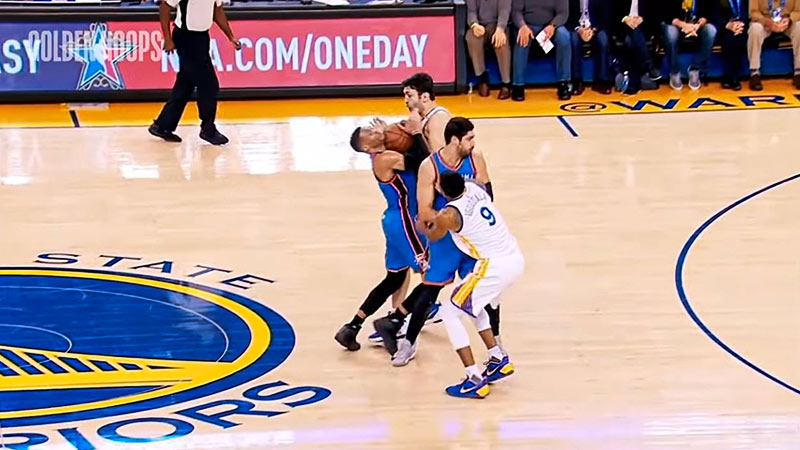Basketball is a sport that involves various statistics, terminologies, and abbreviations. One such abbreviation that often appears in basketball discussions and stat sheets is “PF.”
If you’re new to the game or simply curious about its meaning, this article will provide you with a comprehensive understanding of what PF means in basketball.
We will explore its significance in the NBA, its role in basketball statistics, different types of personal fouls, and the distinction between PF and other abbreviations commonly used in the sport. Let’s get started now.
What Does PF Mean in Basketball?
PF in basketball stands for Personal Foul. It is a violation committed by a player involving illegal physical contact with an opponent.
The number of personal fouls is tracked for individual players and teams throughout the game.
If a player accumulates a certain number of personal fouls, they may be disqualified from further participation. PF is an essential statistic that reflects a player’s defensive performance and discipline.
It is displayed in stat sheets and box scores to evaluate a player’s impact on the game and their defensive presence.
PF in NBA
In the NBA, “PF” stands for Personal Foul. A personal foul is a violation committed by a player that involves illegal physical contact with an opponent.
When a player commits a personal foul, it results in certain consequences, such as the opposing team being awarded free throws or the team committing the foul accumulating fouls that can impact their overall performance.
Personal fouls can occur in various situations during the game, such as pushing, holding, tripping, charging, or making excessive contact with an opponent.
The number of personal fouls committed by a player is tracked throughout the game, and if a player reaches a certain limit, they may be disqualified from further participation.
PF in Stats
In basketball statistics, PF refers to the number of personal fouls accumulated by an individual player or a team. It provides an indication of the player’s or team’s defensive performance and discipline.
The PF statistic helps evaluate a player’s ability to defend without committing excessive fouls, as fouling too frequently can lead to disadvantages for the team, such as giving the opponent free throw opportunities or limiting playing time due to foul trouble.
In stat sheets or box scores, you will often find the PF column, which displays the number of personal fouls committed by each player.
This information allows fans, coaches, and analysts to assess a player’s impact on the game and their defensive presence.
Types of Personal Fouls (PF) in Basketball
Within the realm of personal fouls, there are different types that can occur during a basketball game.
These types provide further insight into the nature of the fouls and their implications. Here are some common types of personal fouls:
Blocking Foul

This foul occurs when a defensive player moves into the path of an offensive player and makes contact, impeding their progress.
The defensive player is not in a legal guarding position and is considered responsible for the contact.
Blocking fouls often happen when the offensive player is attempting to drive to the basket or make a move toward the basket.
Charging Foul
A charging foul occurs when an offensive player initiates contact with a defensive player who has established a legal guarding position.
The defensive player must be stationary or in motion but have already established position before contact occurs. The offensive player is typically driving toward the basket and is responsible for the contact.
Reaching-in Foul
This foul is committed when a player attempts to steal or knock the ball away from an opponent but makes contact with the opponent’s arm or body instead.
Reaching-in fouls are often called when a player’s hand makes contact with the ball-handlers hand or forearm while attempting to steal the ball.
Holding Foul
A holding foul occurs when a player grabs onto an opponent or restricts their movement by using their hands, arms, or body.
Holding fouls often occur when players are jostling for position in the paint or when defending off-ball movement.
It is important for defenders to maintain a legal defensive position without impeding the offensive player’s freedom of movement.
In addition to personal fouls, there is another type of infraction in basketball known as a technical foul.
While not classified as a personal foul in some instances, a technical foul is issued for unsportsmanlike conduct, disrespectful behavior towards officials or opponents, or excessive complaining.
Technical fouls typically result in free throws for the opposing team and may lead to ejection or other disciplinary actions depending on the severity of the infraction.
Difference Between PF and PA in Basketball

In basketball, “PF” stands for Personal Foul. It is a statistic that tracks the number of fouls committed by an individual player or a team.
A personal foul occurs when a player makes illegal physical contact with an opponent, such as pushing, holding, or tripping.
Each player is allowed a certain number of personal fouls before being disqualified from the game.
Personal fouls are crucial because they can result in penalties for the opposing team, such as free throw opportunities or possession of the ball.
Keeping the number of personal fouls low is important for players and teams to maintain their defensive presence while avoiding unnecessary penalties.
PA (Points Against/Points Allowed)
On the other hand, “PA” stands for Points Against or Points Allowed. It represents the number of points scored by the opposing team against a specific team or player.
PA is a defensive statistic that reflects a team’s ability to prevent the opponent from scoring.
Points Against is a key measure of a team’s defensive performance. It indicates how well a team can limit the opposing team’s scoring opportunities and how effective they are at defending their basket. The lower the Points Against, the stronger the defense of a team.
Assessing Defensive Prowess
Both PF and PA are important statistics that contribute to evaluating a team’s defensive prowess.
While PF focuses on the individual or team’s ability to defend without committing fouls, PA provides an overall measure of how well a team can prevent the opponent from scoring.
By tracking PF and PA, coaches, analysts, and fans can gain insights into a team’s defensive strengths and weaknesses.
It helps identify players who may struggle with fouling tendencies and areas where the team needs to improve defensively.
Difference Between PF and PT in Basketball
In the world of basketball, abbreviations are commonly used to represent various statistics and aspects of the game.
Two such abbreviations are “PF” and “PT,” which stand for Personal Foul and Points, respectively.
While they may appear similar, it is important to understand the difference between these terms as they represent distinct aspects of the game.
Let’s delve deeper into each of these abbreviations and explore their significance.
PF – Personal Foul

The abbreviation “PF” stands for Personal Foul, and it refers to the number of fouls committed by a player or a team during a basketball game.
A personal foul occurs when a player makes illegal physical contact with an opponent, such as pushing, holding, or tripping.
Each player is allowed a limited number of personal fouls before they are disqualified from the game. Personal fouls are used to penalize players for actions that violate the rules and regulations of the game.
Tracking personal fouls is important because it reflects a player’s defensive behavior and discipline on the court.
A high number of personal fouls can indicate aggressive or reckless play, while a low number suggests good defensive discipline.
Additionally, teams need to manage their collective fouls to avoid entering the penalty situation, where the opposing team receives free throws for each subsequent foul.
PT – Points
On the other hand, “PT” stands for Points, which represents the number of points scored by a player or a team during a basketball game.
Points are the fundamental objective of the game, and the team with the most points at the end of the game emerges as the winner.
Points can be earned through various methods, including field goals (shots made from the field), free throws (uncontested shots awarded for fouls), and three-pointers (shots made from beyond the arc).
Tracking points is crucial because it helps evaluate a player’s or team’s offensive performance and scoring ability.
Points reflect a player’s skill in finding scoring opportunities, their shooting accuracy, and their ability to contribute to the team’s overall offensive output.
It is often the leading statistic used to determine the top scorers in a game, season, or even throughout a player’s career.
The Distinction between PF and PT
While both PF and PT are important statistics in basketball, it is crucial to recognize their distinct meanings and significance.
PF focuses on fouls committed, serving as a measure of a player’s or team’s defensive behavior and discipline. It is a metric that penalizes illegal actions on the court.
On the other hand, PT focuses solely on scoring and represents a player’s or team’s offensive performance. It highlights the ability to put points on the scoreboard and contributes to the overall success of the team.
FAQs
How many personal fouls are allowed in basketball?
In the NBA, a player is allowed six personal fouls before they are disqualified from the game.
In NCAA college basketball, the limit is five personal fouls, and in high school basketball, it may vary depending on the governing body or state regulations.
What happens when a player commits a personal foul in basketball?
When a player commits a personal foul, the opposing team is typically awarded free throws, depending on the severity of the foul and the game situation.
Additionally, personal fouls are recorded for individual players and teams, which can impact their playing time and overall strategy.
Can a team continue playing if all their players foul out?
Yes, a team can continue playing even if all their players foul out. However, if a team is left with fewer than five players due to fouling out or injuries, they will be required to continue with the remaining players or forfeit the game.
Can a player be ejected from a game for personal fouls?
While personal fouls can lead to disqualification, it is not an automatic ejection from the game.
However, if a player commits a flagrant foul, or technical foul, or accumulates multiple unsportsmanlike conduct fouls, they may be ejected from the game.
Do personal fouls carry over from one game to another in basketball?
No, personal fouls do not carry over from one game to another. Each game is independent, and players’ personal foul counts reset at the start of each game.
Wrapping Up
The meaning of “PF” in basketball is essential for fans, players, and analysts alike. PF stands for Personal Foul and represents the number of fouls committed by a player or a team.
It plays a significant role in evaluating defensive performance, assessing player discipline, and influencing game dynamics.
Different types of personal fouls exist in basketball, and distinguishing PF from other abbreviations like PA and PT is crucial for interpreting basketball statistics accurately.
So, the next time you come across “PF” in a basketball conversation or a stat sheet, you’ll have a clear understanding of its significance. Thank you.







